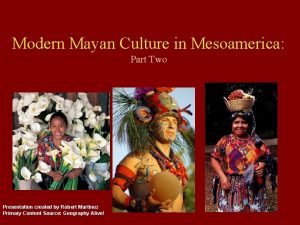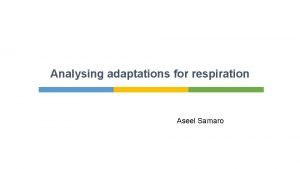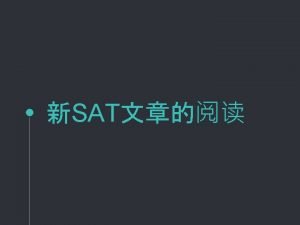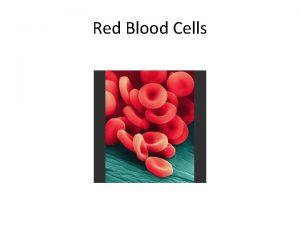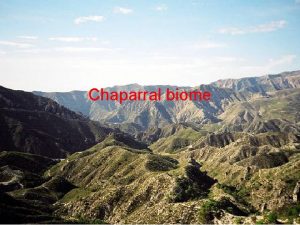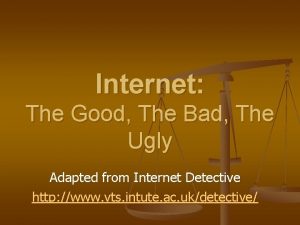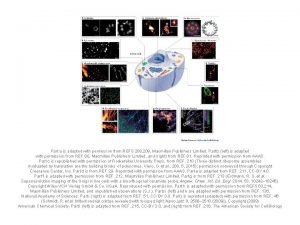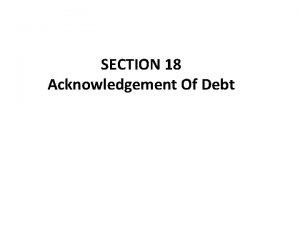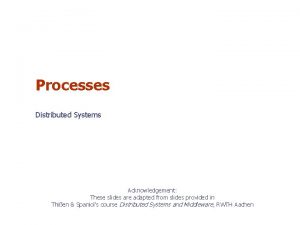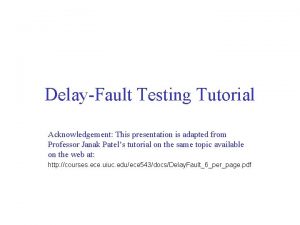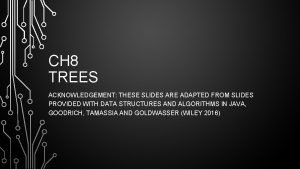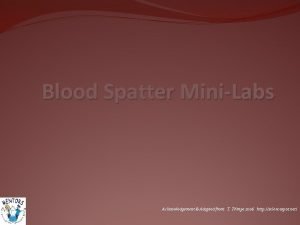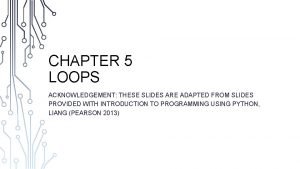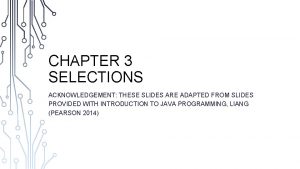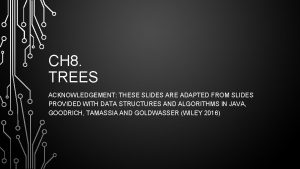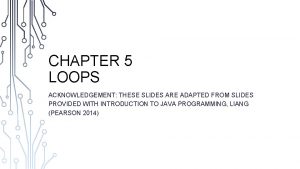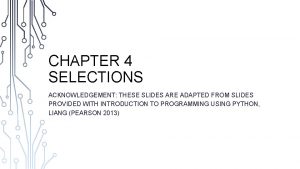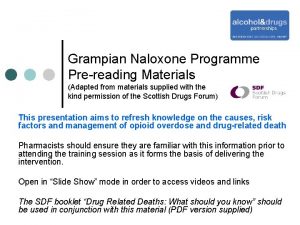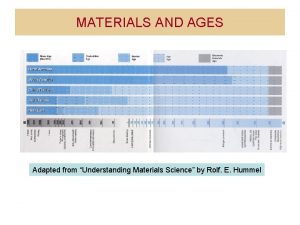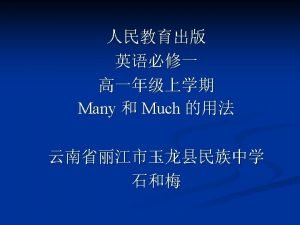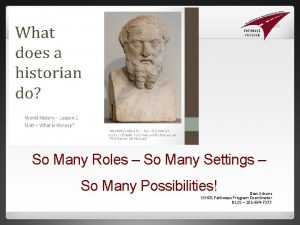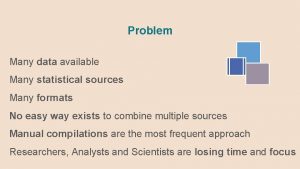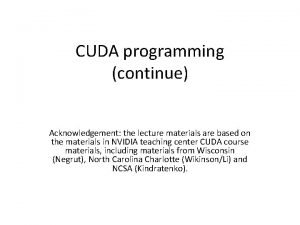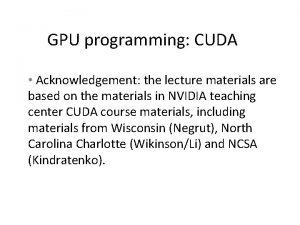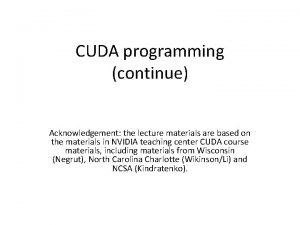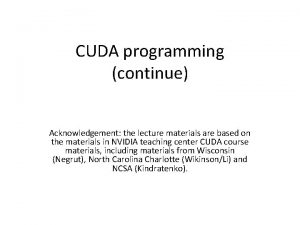Acknowledgement Many of the materials are adapted from






































- Slides: 38

Acknowledgement: Many of the materials are adapted from Prof. Jechang Jeong’s excellent presentation on international coding standards. Computer Vision – Coding Standards Hanyang University Jong-Il Park

Topics to be covered n International coding standards v Background and brief history v Key techniques in Ø JPEG Ø MPEG-1, 2, 4 * Only image/video coding techniques will be covered Department of Computer Science and Engineering, Hanyang University

Multimedia Everywhere n Towards Multimedia : Consumer Electronics Computer Multimedia Tele. Communication Broadcasting Department of Computer Science and Engineering, Hanyang University

Still Picture Compression Standards n 1980 : ITU-T T. 4 : G 3 FAX for PSTN n n Modified Huffman and Modified READ 1984 : ITU-T T. 6 : G 4 FAX for ISDN Modified MR 1992 : JPEG (ISO 10918, ITU-T T. 81) : Color Still Pictures used for Color Fax, Electronic Still Camera, Color Printer, Computer Applications etc Lossless/Lossy Modes, Baseline/Extended Modes, Progressive/Sequential Modes DPCM + DCT + Q + RLE + Huffman/Arithmetic Codes Motion JPEG can be used for Moving Pictures. 1993 : JBIG (ISO 11544, ITU-T T. 82) : Bi-level Pictures Improvement on T. 4 and T. 6 Recently: JPEG-LS, JBIG 2, etc n n Department of Computer Science and Engineering, Hanyang University

Moving Picture Compression Standards n 1982 : ITU-R BT. 601 : Studio Quality PCM Component Video Common to 525/60 and 625/50 Systems 13. 5 MHz Sampling, 8 bit/sample, 4: 2: 2 Format n 1990 : ITU-T H. 261 : Video Phone/Conference Application via ISDN Bitrate = p x 64 kbps, p = 1 -30 MC DPCM + DCT + Q + RLE + Huffman Codes Reference Model 1 - 8 n 1992 : MPEG-1 Video : DSM Applications (e. g. Video CD) Bitrate = 1. 5 Mbps MC DPCM + DCT + Q + RLE + Huffman Codes GOP Structure for Random Access and Error Recovery (I, P, B Frames) Simulation Model 1 - 3 Department of Computer Science and Engineering, Hanyang University

Moving Picture Compression Standards(Cont. ) n 1994 : MPEG-2 Video (ISO 13818 -2, ITU-T H. 262) : Generic Algorithm for Various Applications (Broadcasting, Communication, Network, DSM etc) 5 Profiles of Functionality (Simple, Main, Spatial Scalable, SNR Scalable, High) 4 Levels of Resolution (Low, Main, High-1440, High) Deals with Interlaced Scan as well as Progressive Scan Field/Frame ME & DCT, Dual Prime ME, Intra VLC, Alternate Scan, Nonuniform Q, etc n 1993 : ITU-R CMTT. 721 : 140 Mbps Contribution Quality Video Adaptive DPCM, Componentwise n 1993 : ITU-R CMTT. 723 : 34 -45 Mbps Contribution Quality Video MC DPCM + DCT + Q + RLE + Huffman Codes Department of Computer Science and Engineering, Hanyang University

Moving Picture Compression Standards(Cont. ) n 1995 : ITU-T H. 263 : Videophone via PSTN Bitrate < 64 kbps (V. 34 modem = 33. 6 kbps, Recent modem = 56 kbps) Improved version of H. 261 n 1998 : MPEG-4 Bitrates < 2 Mbps Targets: Multimedia data base access Wireless multimedia communication Components of H. 263 are incorporated Content-based compression Synthetic and natural video/audio Multiple tools/algorithms/profiles => Flexibility n 1999 : MPEG-4 Version 2, MPEG-7 Department of Computer Science and Engineering, Hanyang University

Continuous-tone still image r JPEG(Joint Photographic Experts Group) Applications : color FAX, digital still camera, multimedia computer, internet JPEG Standard consists of - a lossy baseline coding system - an extended coding system for greater compression, higher precision or progressive reconstruction applications - a lossless independent coding system for reversible compression References - ITU-T recommendation T. 81, “Information Technology - Digital compression and Coding of Continuous-Tone Still Images Requirements and Guideline”, 92. 2 - K. R. Rao, J. J. Hwang, “Techniques & Standards for Image, Video & Audio Coding”, Prentice Hall PTR, 1996 Department of Computer Science and Engineering, Hanyang University

Baseline system r Baseline system : most widely used among JPEG standards Data precision - 8 bits for input and output - 11 bits for quantized DCT coefficients Algorithm - DCT + quantization + variable length coding Compression Guideline - 0. 25 ~ 0. 5 bits/pixel : moderate to good quality, some applications - 0. 5 ~ 0. 75 bits/pixel : good to very good quality, many applications - 0. 75 ~ 1. 5 bits/pixel : excellent quality, most applications - 1. 5 ~ 2. 0 bits/pixel : indistinguishable (visually lossless) quality, most demanding applications Department of Computer Science and Engineering, Hanyang University

Block diagram of baseline system r Baseline system encoder r Baseline system decoder Department of Computer Science and Engineering, Hanyang University

Quantization and inverse quant. r Quantization table - No default values for quantization tables - Application may specify the tables - Q(u, v) : quantization table integer value from 1 to 255 Department of Computer Science and Engineering, Hanyang University

Example f (x, y) F (u, v) FDCT FQ (u, v) Quant. r (x, y) e (x, y) Inverse Q & IDCT Department of Computer Science and Engineering, Hanyang University

Entropy coding r DC Coefficient Coding Differential Coding DC coefficients of adjacent blocks are strongly correlated. VLC(Huffman Coding) Department of Computer Science and Engineering, Hanyang University

Entropy coding(Cont. ) r AC coefficients Coding - Zigzag Scanning - VLC(Variable Length Coding, Huffman Coding) Department of Computer Science and Engineering, Hanyang University

Eg. JPEG Compression Original image (24 bpp) JPEG Compressed image (8: 1 -- 3 bpp) JPEG Compressed image ( 32: 1 - 0. 75 bpp ) JPEG Compressed image ( 128: 1 - 0. 1875 bpp ) Department of Computer Science and Engineering, Hanyang University

MPEG Digital Video Technology o MPEG-1( ISO/IEC 11172 ) and MPEG-2( ISO/IEC 13818 ) Applications : MPEG-1 : Digital Storage Media(CD-ROM…) MPEG-2 : Higher bit rates and broader generic applications ( Consumer electronics, Telecommunications, Digital Broadcasting, HDTV, DVD, VOD, etc. ) Coding scheme : Spatial redundancy : DCT + Quantization Temporal redundancy : Motion estimation and compensation Statistical redundancy : VLC References : - ISO/IEC 11172 -2 (MPEG-1), ISO/IEC 13818 -2 (MPEG-2) - K. R. RAO and J. J. HWANG, “TECHNIQUES & STANDARDS FOR IMAGE • VIDEO & AUDIO CODING, ” Prentice Hall, 1996. Department of Computer Science and Engineering, Hanyang University

MPEG Overview o MPEG : - Motion Picture Experts Group - Specifies a standard compression, transmission, and decompression scheme for video and audio. - ISO/IEC 11172 : MPEG-1 - ISO/IEC 13818 : MPEG-2 - Consists of 3 parts. Part 1 : System Part 2 : Video Part 3 : Audio Department of Computer Science and Engineering, Hanyang University

MPEG compression of video o How to remove spectral, spatial, temporal, and statistical redundancy? Department of Computer Science and Engineering, Hanyang University

Intra-frame compression Department of Computer Science and Engineering, Hanyang University

Removing spatial redundancy o Pixel Coding using the DCT • As human eyes are insensitive to HF color changes, the R, G, B signal is converted into a luminance and two color difference signals. We can remove redundancy more on U, V than on Y. • The top left DCT component is taken as the dc datum for the block. • DCT coefficients to the right are increasingly higher horizontal spatial freqs. DCT coefficients below are higher vertical spatial frequencies. Department of Computer Science and Engineering, Hanyang University

Inter-frame compression Department of Computer Science and Engineering, Hanyang University

Temporal redundancy o Inter-frame prediction & motion estimation • This really reduces the overall bit rate from frame to frame! Department of Computer Science and Engineering, Hanyang University

Motion estimation Department of Computer Science and Engineering, Hanyang University

Putting it all together o I, P, B Frames • The Intra Frames contain full picture information • Predicted(P) Frames are predicted from past I, or P frames • Bi-directional predicted frames offer the greatest compression and use past and future I & P frames for motion compensation. Department of Computer Science and Engineering, Hanyang University

Building the elementary stream • This slide shows how the actual blocks, slices, frames etc. are all put together to form the elementary stream • Along with the actual picture data, header information is required to reconstruct the I, B, P frames. This header structure is shown. • The next stage is to take this ES and convert it into something that can be transmitted and decoded at the other end. Department of Computer Science and Engineering, Hanyang University

Ordering frames o Frame Reordering Department of Computer Science and Engineering, Hanyang University

MPEG-4 o MPEG-4( ISO/IEC 14496 ) Applications : Internet Multimedia Wireless Multimedia Communication Multimedia Contents for Computers and Consumer Electronics Interactive Digital TV Coding scheme : Spatial redundancy : DCT + Quantization, Wavelet Transform Temporal redundancy : Motion estimation and compensation Statistical redundancy : VLC (Huffman Coding, Arithmetic Coding) Shape Coding : Context-based Arithmetic Coding References : - ISO/IEC 14496 Department of Computer Science and Engineering, Hanyang University

Interactive television Department of Computer Science and Engineering, Hanyang University

Scene composition Department of Computer Science and Engineering, Hanyang University

MPEG-4 Department of Computer Science and Engineering, Hanyang University

MPEG-4: Background Department of Computer Science and Engineering, Hanyang University

MPEG-4: Concept Department of Computer Science and Engineering, Hanyang University

MPEG-4: Scene composition Department of Computer Science and Engineering, Hanyang University

MPEG-4 Video: Summary Department of Computer Science and Engineering, Hanyang University

MPEG-4 Decoder Department of Computer Science and Engineering, Hanyang University

Sprite in MPEG-4 Department of Computer Science and Engineering, Hanyang University

SNR Scalability Department of Computer Science and Engineering, Hanyang University

Spatial Scalability Department of Computer Science and Engineering, Hanyang University
 Antigentest åre
Antigentest åre Discovery synoynm
Discovery synoynm The outsiders adapted for struggling readers
The outsiders adapted for struggling readers Mensajes subliminales camel
Mensajes subliminales camel How is amoeba adapted for gas exchange bbc bitesize
How is amoeba adapted for gas exchange bbc bitesize In what ways have the highland maya adapted to modern life?
In what ways have the highland maya adapted to modern life? Behavioral adaptations of zebras
Behavioral adaptations of zebras Adapted animals in the rainforest
Adapted animals in the rainforest This passage is adapted from jane austen
This passage is adapted from jane austen How have plants adapted to the rainforest
How have plants adapted to the rainforest Xerophytic adaptation in plants
Xerophytic adaptation in plants Best brother quotes
Best brother quotes Erythroposis
Erythroposis Spermopsida as successful land plants
Spermopsida as successful land plants Chaparral biome location
Chaparral biome location Adapted from the internet
Adapted from the internet Adapted with permission from
Adapted with permission from Man made map
Man made map Adopting and adapting teaching materials
Adopting and adapting teaching materials Go noodle cant stop the feeling
Go noodle cant stop the feeling Direct materials budget with multiple materials
Direct materials budget with multiple materials Example useful and harmful materials
Example useful and harmful materials Các loại đột biến cấu trúc nhiễm sắc thể
Các loại đột biến cấu trúc nhiễm sắc thể Vẽ hình chiếu đứng bằng cạnh của vật thể
Vẽ hình chiếu đứng bằng cạnh của vật thể Biện pháp chống mỏi cơ
Biện pháp chống mỏi cơ Phản ứng thế ankan
Phản ứng thế ankan Gấu đi như thế nào
Gấu đi như thế nào Sự nuôi và dạy con của hổ
Sự nuôi và dạy con của hổ Thiếu nhi thế giới liên hoan
Thiếu nhi thế giới liên hoan điện thế nghỉ
điện thế nghỉ Một số thể thơ truyền thống
Một số thể thơ truyền thống Trời xanh đây là của chúng ta thể thơ
Trời xanh đây là của chúng ta thể thơ Frameset trong html5
Frameset trong html5 Số nguyên là gì
Số nguyên là gì Vẽ hình chiếu vuông góc của vật thể sau
Vẽ hình chiếu vuông góc của vật thể sau đặc điểm cơ thể của người tối cổ
đặc điểm cơ thể của người tối cổ Các châu lục và đại dương trên thế giới
Các châu lục và đại dương trên thế giới Chụp tư thế worms-breton
Chụp tư thế worms-breton Thế nào là hệ số cao nhất
Thế nào là hệ số cao nhất





